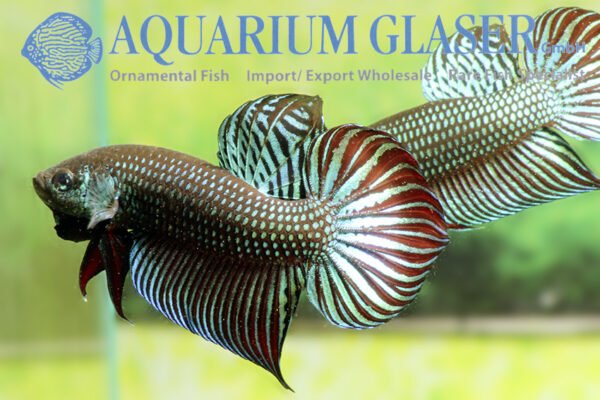Show Betta Variations Spotlight, Breeding and Reproduction, MAA Blog
Spade Tail Betta Fish: The Vibrant Hybrid with a Rich Pedigree
The Spade Tail Betta Fish stands as a testament to the beauty and diversity that selective breeding can achieve. Known for their distinctive tail shape and vibrant color patterns, these fish are a favorite among enthusiasts and collectors. This article delves into the fascinating history, characteristics, care requirements, and breeding of Spade Tail Betta Fish, providing a comprehensive guide for anyone interested in these remarkable creatures.
The Origins and History of Spade Tail Betta Fish
The Spade Tail Betta Fish has a rich history that traces back to the early hybridization of Betta splendens with other species in the Splenden group. These hybrids were initially created to enhance certain desirable traits, such as color, fin shape, and aggression levels, making them popular in both the ornamental fish trade and traditional fighting circles.
The influence of Betta smaragdina, or the Emerald Betta, is particularly notable in the Spade Tail Betta’s lineage. Betta smaragdina, known for its metallic green-blue coloration and relatively peaceful demeanor, contributed significantly to the genetic pool of the Spade Tail variety. This hybridization resulted in a fish that not only showcases the vibrant colors of its ancestors but also possesses a unique tail shape that resembles a spade, thus giving it its name.
Characteristics and Appearance
Distinctive Spade Tail
The defining feature of the Spade Tail Betta Fish is its tail, which tapers to a pointed end, reminiscent of a spade. This unique tail shape sets it apart from other Betta varieties, such as the Halfmoon or Crowntail. The tail’s graceful tapering adds an element of elegance to the fish’s overall appearance, making it a striking addition to any aquarium.
Color Varieties
Modern Spade Tail Betta Fish come in a wide array of colors and patterns, thanks to extensive breeding programs. From solid hues of red, blue, and black to more complex patterns like marbling and bi-color, these fish exhibit an impressive range of visual diversity. The iridescence inherited from Betta smaragdina adds an extra layer of brilliance, making these fish shimmer under aquarium lighting.
Size and Body Shape
Typically, Spade Tail Bettas reach an average size of about 2.5 to 3 inches in length. They have a streamlined, torpedo-shaped body that enhances their swimming efficiency. Males tend to have more elaborate finnage compared to females, which often have shorter, more practical fins.
Behavior and Temperament
Aggression Levels
Like most Betta fish, Spade Tails can exhibit aggressive behavior, especially males. They are known for their territorial nature and will often display flaring behaviors when confronted with other males. However, the influence of Betta smaragdina in their lineage can sometimes result in a slightly more docile demeanor, particularly in females.
Compatibility with Other Fish
Spade Tail Betta Fish can be kept in community tanks, provided careful consideration is given to tank mates. Suitable companions include peaceful species that do not possess long fins, which could provoke the Betta’s aggression. Examples of compatible tank mates are Corydoras catfish, small tetras, and certain types of snails.
Habitat and Tank Requirements
Aquarium Size
A single Spade Tail Betta can thrive in a tank as small as 5 gallons, although larger tanks are recommended to provide ample space for swimming and exploration. When housing multiple fish, ensure the tank is sufficiently large to prevent territorial disputes.
Water Conditions
Maintaining optimal water conditions is crucial for the health of Spade Tail Betta Fish. The water temperature should be kept between 76-82°F (24-28°C), with a pH level ranging from 6.5 to 7.5. Regular water changes and a good filtration system are essential to keep the water clean and free of harmful toxins.
Tank Setup
A well-planted tank with plenty of hiding spots is ideal for Spade Tail Bettas. Live plants such as Java fern, Anubias, and floating plants like Duckweed provide both cover and enrichment. Adding driftwood and smooth rocks can also help create a natural and stimulating environment.
Diet and Nutrition
Feeding Habits
Spade Tail Betta Fish are carnivorous and require a protein-rich diet to maintain their vibrant colors and health. High-quality Betta pellets or flakes should form the staple of their diet, supplemented with live or frozen foods such as brine shrimp, bloodworms, and daphnia.
Feeding Frequency
Feed Spade Tail Bettas small amounts of food 2-3 times a day, ensuring they consume the food within a few minutes. Overfeeding can lead to obesity and water quality issues, so it is essential to monitor their intake carefully.
Breeding Spade Tail Betta Fish
Breeding Preparation
To breed Spade Tail Betta Fish, select a healthy male and female pair. Condition them with a varied diet rich in live foods to enhance their breeding readiness. Once conditioned, introduce the female to the male’s tank using a divider to allow them to see each other without physical contact.
Spawning Process
When the female shows signs of readiness, such as vertical stripes and a receptive posture, remove the divider. The male will build a bubble nest at the water’s surface, and courtship will commence. After a successful mating embrace, the female will release eggs, which the male will fertilize and place in the bubble nest.
Raising Fry
After spawning, it is crucial to remove the female to prevent aggression from the male. The male will care for the eggs and fry, guarding the nest diligently. Once the fry are free-swimming, typically after 3-4 days, the male can be removed to prevent him from eating the fry. The fry should be fed infusoria or commercial fry food initially, transitioning to larger foods as they grow.
Health and Common Diseases
Preventative Measures
Maintaining pristine water conditions and a balanced diet is the best way to prevent common diseases in Spade Tail Betta Fish. Regular tank maintenance, including water changes and filter cleaning, is essential to keep harmful pathogens at bay.
Common Ailments
Spade Tail Bettas can be susceptible to common fish diseases such as ich, fin rot, and velvet. Early detection and treatment are critical to ensure a quick recovery. Quarantining new fish before introducing them to the main tank can also help prevent the spread of diseases.
Spade Tail Betta Fish: A Collector’s Delight

Popularity Among Collectors
The unique tail shape and vibrant colors of Spade Tail Betta Fish make them highly sought after by collectors and enthusiasts. Their captivating appearance and relatively easy care requirements contribute to their popularity in the ornamental fish trade.
Showcasing Spade Tail Bettas
Spade Tail Bettas are often showcased in competitions and exhibitions, where judges assess them based on criteria such as color, finnage, and overall health. Owning a prize-winning Spade Tail Betta can be a source of pride and accomplishment for breeders and hobbyists alike.
Environmental and Ethical Considerations
Sustainable Breeding Practices
As with any ornamental fish, it is important to practice sustainable breeding to avoid overexploitation of wild populations. Ethical breeders prioritize the health and well-being of their fish, ensuring they are raised in humane conditions and sold to responsible owners.
Promoting Conservation Awareness
Educating hobbyists about the natural habitats and conservation status of wild Betta species can foster a greater appreciation for these fish. Supporting conservation efforts and sustainable breeding practices helps ensure the long-term survival of both wild and captive Betta populations.
FAQs
What makes Spade Tail Betta Fish unique?
Spade Tail Betta Fish are unique due to their distinctive spade-shaped tail, vibrant colors, and hybrid lineage, which includes Betta smaragdina.
How do you care for Spade Tail Betta Fish?
Caring for Spade Tail Bettas involves maintaining optimal water conditions, providing a protein-rich diet, and creating a well-planted tank with plenty of hiding spots.
Can Spade Tail Betta Fish live with other fish?
Spade Tail Bettas can live with other peaceful species that do not have long fins, such as Corydoras catfish and small tetras, to avoid triggering aggression.
What should I feed my Spade Tail Betta Fish?
Feed Spade Tail Bettas high-quality Betta pellets or flakes, supplemented with live or frozen foods like brine shrimp, bloodworms, and daphnia.
How do you breed Spade Tail Betta Fish?
To breed Spade Tail Bettas, condition a healthy male and female pair with a protein-rich diet, introduce them carefully, and provide the male with a suitable environment to build a bubble nest.
What are common diseases in Spade Tail Betta Fish?
Common diseases include ich, fin rot, and velvet. Maintaining clean water and a balanced diet, along with early detection and treatment, can help prevent and manage these ailments.
Conclusion
The Spade Tail Betta Fish is a captivating hybrid that showcases the beauty and diversity of Betta species. With its unique tail shape, vibrant colors, and relatively easy care requirements, it is no wonder that these fish have become a favorite among collectors and enthusiasts. By understanding their history, characteristics, and care needs, hobbyists can ensure their Spade Tail Bettas thrive and continue to bring joy and fascination to aquariums worldwide.

